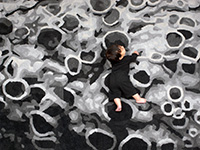Designers put a lot of effort into facilitating unconscious movement across ground surfaces. These carpets, in contrast, are intended to bring people’s attention to the flat plane underfoot by making it appear to swell, undulate, recede, emit light, slope. Instead of disappearing discretely into the background, they playfully enliven and transform the spaces they occupy.
Some designs invite people to move them around, to interact with them, as opposed to leaving them rooted in one place.
Mirror-image carpet tiles encourage users to set them up in different configurations, from the size of a doormat to an entire room.
Other designs are invitations to occupy spaces visually that we can’t occupy physically, providing haptic approximations of what the experience might be like, such as sitting on the beautifully detailed back of a shield bug or hopping from green stamen to stamen over velvetty red waves.
I came to carpet design from making large-scale paintings of architectural spaces – it was easier to build up their heavily collaged surfaces on the floor, and I was always surprised by the skewed perspectives under my feet. I wanted to work with images that were meant to be seen exclusively that way and developed an interest in proprioception – how we perceive our bodies’ position in space – and in the role that (peripheral) vision plays in our kinaesthetic sense of verticality and orientation.
